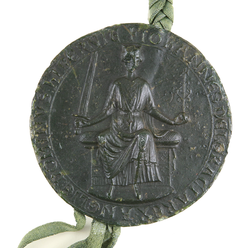| There are two main types of seal to consider, those of the nobility and those of the highest members of the clergy. The seals of the nobility, taking their cue from the reverse of the Great Seal of England, always featured equestrian designs in a circular seal, which was usually around 4-5cm in diameter. It would have borne a legend around the edge, naming the seal's owner and following the form of 'SIGILLVM CHRISTOPHORI FILII ROBERTI' ('the seal of Christopher FitzRobert'). Episcopal seals, on the other hand, always featured a depiction of the owner in their vestments, standing in a vessica shaped seal (a pointed oval), with a legend around the edge naming the owner and his diocese. This would have followed the form of 'THOMASIUS DEI GRATIA ELIAE EPISCOPUS' ('Thomas, by the grace of God, Bishop of Ely'). Both types of seal matrix would typically have been made of lead or silver, and would have featured a loop at the top to hang it by, and a raised ridge along the back to hold it with when sealing. |
| The other unusual seal of interest it a rather important one, the King's Great Seal. Far larger than regular wax seals, it was also a double matrix seal, meaning that it bore images on both sides. To achieve this, there were two separate seal matrices - one bearing an image of the king seated on his throne, the other of the king mounted (it was from this that the seals of the nobility originally descended). Both sides bore legends, and between those they listed the full title of the king. The king's seal was appended to a document in neither of the ways discussed above, but on a braided length of light green silk ribbon, passed through the bottom of a document through three or four holes. As a double seal matrix, it would have required a seal press to apply it to a document. A disk of wax was placed into the first matrix, and the silk ribbon placed on top. A second disk of wax and the second matrix were then placed on top. Each of the matrices had around its edges four lugs, which were used to align them correctly. Finally, the seal press was tightened and pressure applied to produce the finished seal. |
Christopher N


